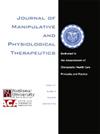澳大利亚青少年疼痛与欺凌之间的关系:对澳大利亚儿童福祉项目横断面数据的二次分析》(Association between Pain and Bullying in Australian Adolescents: A Secondary Analysis of Cross-Sectional Data from the Australian Child Wellbeing Project)。
IF 1.4
4区 医学
Q4 HEALTH CARE SCIENCES & SERVICES
Journal of Manipulative and Physiological Therapeutics
Pub Date : 2023-06-01
DOI:10.1016/j.jmpt.2024.08.009
引用次数: 0
摘要
研究目的本研究旨在描述澳大利亚学童遭受欺凌与疼痛之间的频率和关联强度:我们使用了 2014 年 "澳大利亚儿童福祉项目 "中具有全国代表性的数据,其中包括来自 180 所学校的 8 至 14 岁学生。我们建立了加权多元逻辑回归模型(根据性别和学年进行调整),以量化每周或更频繁发生的欺凌与每周或更频繁发生的疼痛之间的关联。欺凌与疼痛之间关系的估计值以几率比(OR)的形式报告:样本由 5,440 名学童(51.9% 为女性)组成。样本中每周或更频繁出现疼痛的比例为头痛(32.3%)、背痛(23.5%)和胃痛(21.7%)。有 4.3%至 7.9%的参与者表示每周或更频繁地受到欺凌。在报告遭受欺凌的学童中,疼痛发生率为 43.1%至 64.3%。逻辑回归模型显示,报告任何欺凌类型的学童的经历与任何疼痛类型之间存在中强正相关(OR,2.1 [95% CI,1.8-2.5] 至 4.5 [95% CI,3.7-5.6]):结论:报告遭受欺凌的澳大利亚学童更有可能出现头痛、胃痛和背痛。这种中度到高度的正相关与之前国际上研究青少年受欺凌与疼痛之间关系的研究结果一致。这些研究结果对为青少年提供医疗服务的临床医生、教育工作者和医疗保健政策制定者具有重要意义,它们强调了并存的社会心理因素在处理报告疼痛的青少年中的重要作用。本文章由计算机程序翻译,如有差异,请以英文原文为准。
Association Between Pain and Bullying in Australian Adolescents: A Secondary Analysis of Cross-Sectional Data From the Australian Child Wellbeing Project
Objective
This study aimed to describe the frequency, and the strength of the association, between bullying and pain in Australian schoolchildren.
Methods
We used nationally representative data from the 2014 Australian Child Wellbeing Project, comprised students aged 8 to 14 years from 180 schools. Weighted, multiple logistic regression models (adjusting for sex and school year) were constructed to quantify the association between weekly or more frequent bullying and weekly or more frequent pain. Estimates of association for the relationship between bullying and pain were reported as odds ratios (OR).
Results
The sample was comprised of 5,440 schoolchildren (51.9% female). The prevalence rates of weekly or more frequent pain in the sample were headache (32.3%), backache (23.5%), and stomach ache (21.7%). Between 4.3% and 7.9% of participants reported weekly or more frequent bullying. In schoolchildren reporting bullying, the prevalence of pain ranged from 43.1% to 64.3%. Logistic regression modeling showed moderate-to-strong positive associations (OR, 2.1 [95% CI, 1.8-2.5] to 4.5 [95% CI, 3.7-5.6]) between the experiences of schoolchildren reporting any bullying type and any pain type.
Conclusion
Australian schoolchildren who reported bullying were more likely to experience headache, stomach ache, and backache. The moderate-to-strong positive association is consistent with previous international studies that have examined the association between bullying and pain in young people. These findings have significant implications for clinicians who provide care for young people, as well as educators and healthcare policymakers, highlighting the important role of coexisting psychosocial factors in the management of adolescents who report pain.
求助全文
通过发布文献求助,成功后即可免费获取论文全文。
去求助
来源期刊
CiteScore
3.00
自引率
7.70%
发文量
63
审稿时长
29 weeks
期刊介绍:
The Journal of Manipulative and Physiological Therapeutics (JMPT) is an international and interdisciplinary journal dedicated to the advancement of conservative health care principles and practices. The JMPT is the premier biomedical publication in the chiropractic profession and publishes peer reviewed, research articles and the Journal''s editorial board includes leading researchers from around the world.
The Journal publishes original primary research and review articles of the highest quality in relevant topic areas. The JMPT addresses practitioners and researchers needs by adding to their clinical and basic science knowledge and by informing them about relevant issues that influence health care practices.

 求助内容:
求助内容: 应助结果提醒方式:
应助结果提醒方式:


